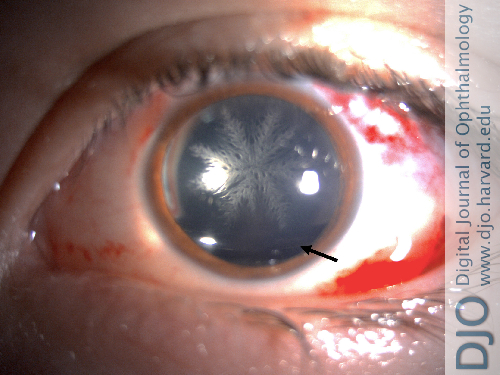Posterior capsular gas cataract
Aug 31, 2021
Volume 27, Number 3
João Heitor Marques, MD | Ophthalmology Department, Centro Hospitalar Universitário do Porto, Portugal
João Leite, MD | Ophthalmology Department, Centro Hospitalar Universitário do Porto, Portugal
Angelina Meireles, MD | Ophthalmology Department, Centro Hospitalar Universitário do Porto, Portugal; Instituto de Ciências Biomédicas Abel Salazar, Universidade do Porto, Portugal

A 16-year-old patient underwent pars plana vitrectomy at Centro Hospitalar Universitário do Porto, Porto, Portugal for rhegmatogenous retinal detachment of the left eye. At the 2-day postoperative visit, corrected distance visual acuity was counting fingers. The photograph of the anterior segment under pharmacologic mydriasis shows a posterior capsular cataract shaped like an ice crystal. The subtle demarcation line inside the eye (black arrow) represents the transition between the aqueous humor (heavier) and endocular SF6 gas (lighter) used for tamponade. Injection of gas into the vitreous cavity allows the retina to stay attached to the retinal pigment epithelium as it heals. Because the vitreous was removed in this case, the avascular lens lacked posterior nutritional support and came into contact with the gas, resulting in the cataract. After 2 weeks, when aqueous humor completely replaced the gas, the cataract resolved, and corrected distance visual acuity improved to 20/30.
 Welcome, please sign in
Welcome, please sign in  Welcome, please sign in
Welcome, please sign in